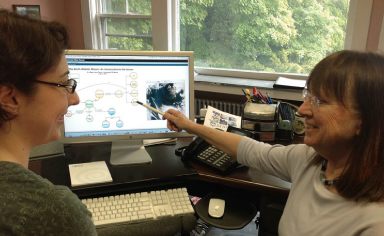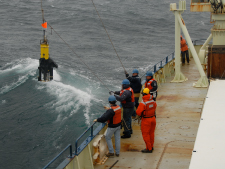Public understanding of ocean science is increasingly important as society faces complex environmental issues that
require rigorous research. Communicating scientific complexity to the public is challenging, thus scientists can benefit
from employing methods that illustrate societal impacts of ocean research. Concept mapping facilitates “deconstructing”
science into discrete ideas and organizing them into graphical formats, thereby increasing scientists’ capacity to
communicate effectively with non-scientists.
For Dr. Mary Jane Perry, using a concept map in the North Atlantic Bloom (NAB) webinar series to explain her research made
sense, but it was not without its challenges: the most demanding part of the webinar process was creating the map and
figuring out how to navigate through the concepts. "It was more work than I expected," admits Mary Jane, "but it was
a good product in the end. I can put 'I did high quality educational outreach' in my NSF annual report. I'm happy when
I can deliver and I feel like I delivered."
"[Concept mapping] is really interesting. It gives you insight into how people think."-Mary Jane Perry |
Incorporating concept mapping into an education and outreach program necessitates rethinking the current presentation norm:
PowerPoint productions. "[Concept mapping is a] useful exercise to organize my own thoughts about science," says Dr. Amala
Mahadevan. Dr. Ivona Cetinic agrees. "Sometimes we are closed in our own little niche," says Ivona. "Concept maps allow scientists to
clear up their thoughts and transfer the main message to [others]." "The challenge," says Amala, "was moving away from a
flow chart towards presenting info synoptically."
Both Dr. Nicole Poulton and Dr. Eric D'Asaro enjoyed the concept mapping. "I don't think it was difficult, just a
different way of thinking," says Eric. The biggest challenge of the NAB outreach program for these scientists was speaking
to an unseen audience. Without visual feedback, it can be difficult to gauge an audience's level of interest and
understanding (the chat option can help with this, allowing listeners to transmit questions in real time without disrupting
the presentation). For Eric, however, using webinars to broadcast his research on a regular basis is inevitable. "We, as an
outreaching community, need to think of a way to reach large numbers of people," says Eric, and that's through media."
Judging by the number of people who attended the series and the quality of the questions they asked, the public is interested.
"It was heartening for me to find out that people want to know about my research," says Amala. "It encourages me to bring it
out to them."






